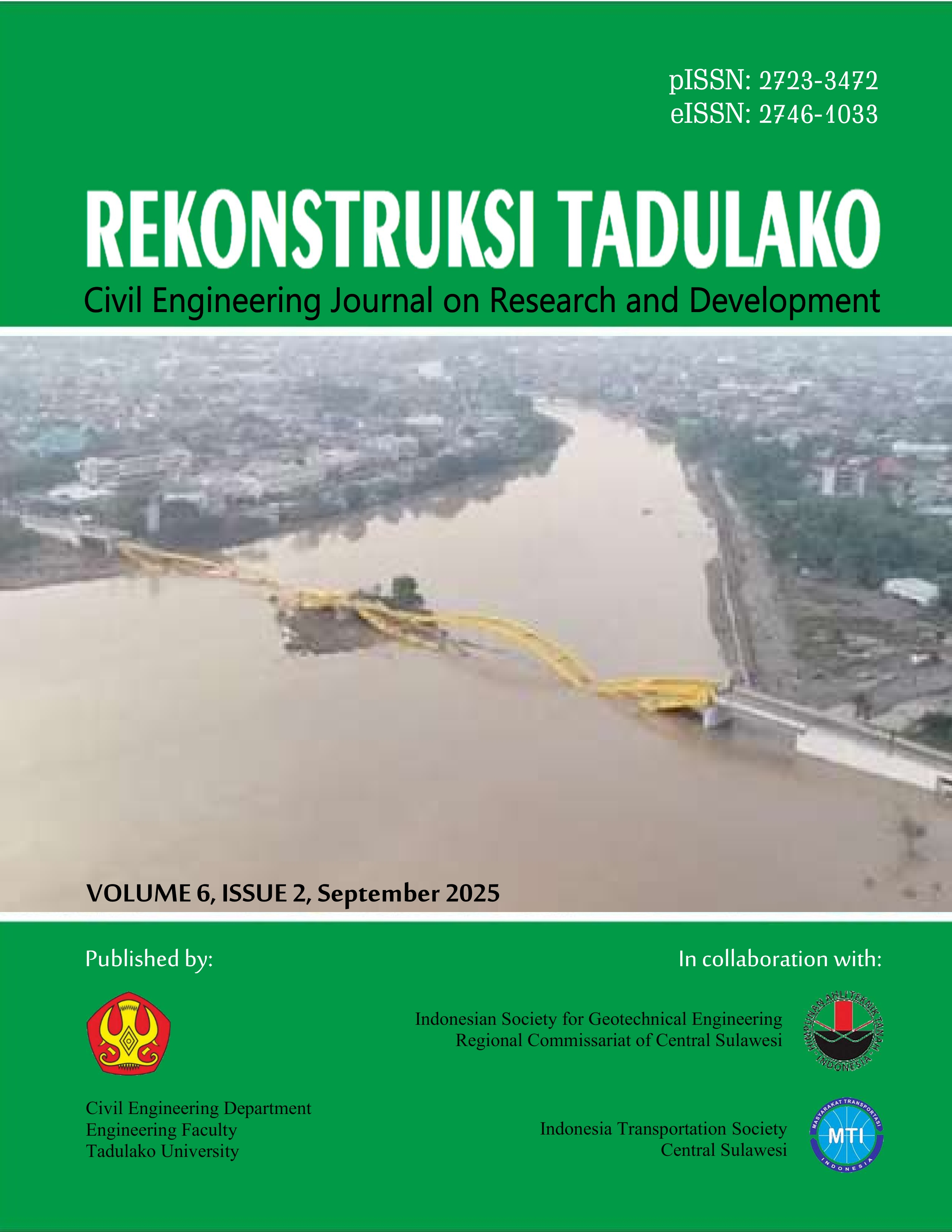Effect of Activator Composition on the Setting Time and Compressive Srength Of Fly Ash–Lime-Based Geopolymer Paste
DOI:
https://doi.org/10.22487/renstra.v6i2.766Keywords:
fly ash, lime, activator, dosage, geopolymer, setting time, compressive strengthAbstract
This study aims to investigate the optimal composition of geopolymer paste based on fly ash and lime to achieve ambient temperature hardening, ideal setting time, and high compressive strength. The primary materials used include Class F fly ash from the Mpanau coal-fired power plant and hydrated lime (calcium hydroxide) at 5% of the fly ash weight. The activators employed were Sodium Silicate (Na2SiO3) and Sodium Hydroxide (NaOH), with Na2O dosage variations of 7.5%, 10%, and 12.5%, and activator modulus (SiO2/Na2O ratio) variations of 0.75, 1.00, and 1.25. The specimens were cylindrical with a diameter of 25 mm and a height of 50 mm, and compressive strength tests were conducted at 3, 7, 14, and 28 days. The results showed that the optimum setting time was achieved at a Na2O dosage of 7.5% with an activator modulus of 0.75 and 1.00, yielding setting times of 88.67 and 60.94 minutes, respectively. The highest compressive strength was recorded at a Na2O dosage of 10% with an activator modulus of 1.25, reaching 29.76 MPa at 28 days. These findings suggest that the composition of the alkaline activator significantly influences the early-age properties and mechanical performance of fly ash–lime-based geopolymer paste
Downloads
References
N.M.D. Lestari, I.M.A.K. Salain, I. Bagus, and R. Widiarsa, “Kuat Tekan Beton Geopolimer Menggunakan Abu Sekam Padi”, Jurnal Spektran, vol. 12, no. 1, p. 35, 2024.
Tim Penyusun, Rencana Umum Energi Daerah (RUED) Provinsi Sulawesi Tengah 2020–2050, Jakarta: Kemetrian ESDM, 2019
H. Kaselle, S. Ruga, and S.A.Z. Amin, “Karakteristik Mortar Geopolimer Berbahan Dasar Fly Ash Dan Bottom Ash”, Seminar Nasional Hasil Penelitian & Pengabdian Kepada Masyarakat, vol. 6, no. 1, p. 66, 2021.
D. Hardjito, S.E. Wallah, D.M.J. Sumajouw, and B.V Rangan, “Introducing Fly Ash-based Geopolymer Concrete: Manufacture and Engineering Properties”, 30 th Conference on Our World In Concrete & Structures, p. 23, 2005.
P. Chindaprasirt, S. Rukzon, and V. Sirivivatnanon, “Resistance to Chloride Penetration of Blended Portland Cement Mortar Containing Palm Oil Fuel Ash, Rice Husk Ash and Fly Ash”, Constroction Building Matererial, vol. 22, no. 5, p. 932, 2008.
W. Wahyuni, S. Subaer, and N. Nurhayati, “Pengaruh Penambahan Abu Sekam Padi Terhadap Struktur dan Sifat Mekanik Geopolimer Berbasis Fly Ash”, Jurnal Sains dan Pendidikan Fisika, vol. 16, p. 171, 2020.
S. Rukzon and P. Chindaprasirt, “Strength and Chloride Resistance of Blended Portland Cement Mortar Containing Palm Oil Fuel Ash and Fly Ash”, International Journal of Minerals Metallurgy and Materials, vol. 16, p. 475, 2009.
A.A. Adam, Strength and Durability Properties of Alkali Activated Slag and Fly Ash-Based Geopolymer Concrete, Melbourne: RMIT University, 2009.
A.A. Adam, “The Effects of Water to Solid Ratio, Activator to Binder Ratio, and Lime Proportion on the Compressive Strength of Ambient-Cured Geopolymer Concrete”, Journal of the Civil Engineering Forum, vol. 5, no. 2, p. 161, 2019.
ASTM C191-19, Standard Test Methods for Time of Setting of Hydraulic Cement by Vicat Needle, West Conshohocke: ASTM, 2019.
ASTM C39/C39M-20, Standard Test Method for Compressive Strength of Cylindrical Concrete Specimens, West Conshohocke: ASTM, 2021.
Y.K. Cho, S. Yoo, S.-H. Jung, and S.-J. Kwon, “Effect of Na 2 O Content, SiO 2 /Na 2 O Molar Ratio, and Curing Conditions on the Compressive Strength of FA-Based Geopolymer”, Construction Building Materrial, vol. 145, p. 253, 2017.
N. Ranjbar, C. Kuenzel, J. Spangenberg, and M. Mehrali, “Hardening Evolution of Geopolymers From Setting to Equilibrium: A Review”, Cement Concrete Composite, vol. 114, p. 103729, 2020.
C. Shi and A. Fernández-Jiménez, “Stabilization/Solidification of Hazardous and Radioactive Wastes with Alkali-Activated Cements,” Journal Hazard Material, vol. 137, no. 3, p. 1656, 2006.
P.W. Ariyadasa, “Macro and Microstructural Evolution of Low-Calcium Fly Ash-Based Geopolymer Mortar Exposed t Sulphuric Acid Corrosion”, Cement and Concrete Research, vol. 178, p. 107436, 2024.
A. Palomo, M.W. Grutzeck, and M.T. Blanco, “Alkali-Activated Fly Ashes: A Cement for the Future”, Cement and Concrete Research, vol. 29, no. 8, p. 1323, 1999.
A. Fernández-Jiménez, E. Flores, O. Maltseva, I. García-Lodeiro, and A. Palomo, “Hybrid Alkaline Cements: Durability and Industrial Applications”, Revista Romana de Materiale/Romanian Journal of Materials, vol. 43, p. 195, 2013.
ASTM C109 , The standard’s title, such as “Standard Test Method for Compressive Strength of Hydraulic Cement Mortars. West Conshohocken: ASTM International, 2016.
L. Simão, E. Fernandes, D. Hotza, M.J. Ribeiro, O.R. K. Montedo, and F. Raupp-Pereira, “Controlling Efflorescence in Geopolymers: A New Approach”, Case Studies in Construction Materials, vol. 15, p. e00740, 2021.
I. Amer, M. Kohail, M.S. El-Feky, A. Rashad, and M. A. Khalaf, “A review on alkali-activated slag concrete”, Ain Shams Engineering Journal, vol. 12, no. 2, p. 1475, 2021.
J. Temuujin, A. Van Riessen, and K.J.D. MacKenzie, “Preparation and characterisation of fly ash based geopolymer mortars,” Construction and Building Material, vol. 24, no. 10, p. 1906, 2010.
D.A. Syaputra, F.R. Nugroho, H.A. Lie, and Purwanto, “Studi Experimental Pengaruh Perbedaan Molaritas Aktivator Pada Perilaku Beton Geopolimer Berbahan Dasar Fly Ash”, Jurnal Karya Teknik Sipil, vol. 7, no. 1, p. 89, 2018.
J. Davidovits, “Geopolymers: Inorganic Polymeric New Materials”, Journal of Thermal Analysis and Calorimetry, vol. 37, pp. 1633, 1991.
D. Joseph, Geopolymer Chemistry and Applications, Newyork: McGwawHill, 2008.
K. Weise, N. Ukrainczyk, and E. Koenders, “Pozzolanic Reactions of Metakaolin with Calcium Hydroxide: Review on Hydrate Phase Formations and Effect of Alkali Hydroxides, Carbonates and Sulfates”, Material and Design, vol. 231, p. 112062, 2023.
Z. Zhang, J.L. Provis, A. Reid, and H. Wang, “Geopolymer Foam Concrete: An Emerging Material for Sustainable Construction”, Construction and Building Material, vol. 56, p. 113, 2014.
W. Tu and M. Zhang, “Behaviour of Alkali-Activated Concrete at Elevated Temperatures: A Critical Review”, Cement Concrete Composite, vol. 138, p. 104961, 2023.
Downloads
Published
How to Cite
Issue
Section
License
Copyright (c) 2025 REKONSTRUKSI TADULAKO: Civil Engineering Journal on Research and Development

This work is licensed under a Creative Commons Attribution 4.0 International License.







 This work is licensed under a
This work is licensed under a 


